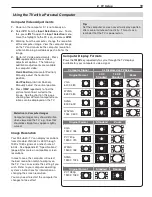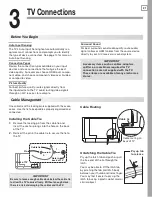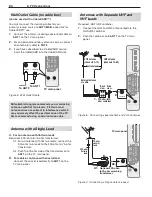
2. TV Setup
15
Setup Procedure for TV Inputs
Power on the TV if not already on.
1.
Connect your devices to the TV, making note
2.
of which TV input is used for each device. See
chapter 3, “TV Connections.”
Note:
If you wish to use an HDMI device’s CEC capa-
bilities, follow the steps in Appendix E.
First select a
device type.
Next perform
IR “learning.”
Sample Auto Input Sensing screen.
When the TV detects a new connection, the
3.
Auto
Sensing
screen for the connection type will display.
Select the device type if required.
Important Note for NetCommand IR Users
Be sure to select the correct device type here. Although
you can change the device type later in the
Inputs
>
Name
menu, any “learned” NetCommand IR codes will be erased
when you make the change.
You can perform NetCommand IR “learning” after
4.
selecting the device type or at a later time when
convenient. To perform now, highlight the Learn
icon and press
ENTER
. See “Initial NetCommand
Setup for Most Devices,” page 57 or “Setting Up
NetCommand Control of an A/V Receiver,” page 61.
Press
5.
EXIT
to close the
Auto Sensing
screen. The
TV will then display the
Auto Sensing
screen for
the next connection it finds.
After completing Auto Input/Auto Output Sensing,
6.
you may wish to set up or change control of your
equipment using one of the home-theater control
methods described in this Owner’s Guide. See
“About Home-Theater Control Systems” on page 17.
Setting Up TV Inputs, continued
Auto Input/Auto Output Sensing Screens
See below for how different connections are handled
by Auto Input/Auto Output Sensing.
Most Device Types.
•
Select the device type
from the on-screen list. The device type you select
here will appear as an icon in the
Input Selection
menu.
Press to move through the device list to highlight
the device type connected to the input. Some device
types also display a sub-menu of names—useful
if using more than one of the same device. See
the sample
Auto Input Sensing
screen shown.
A/V Receiver
•
The TV detects audio connections on the
-
DIGITAL AUDIO OUTPUT
jack and the right (red)
AVR AUDIO OUTPUT
jack.
If using an analog A/V receiver, highlight
-
AV
Receiver
when the
Auto Output Sensing
screen displays. This setting causes the TV
to pass the full range of stereo sound to the
A/V receiver.
For an HDMI connection, select
-
AVR
from
the list of device types if the A/V receiver is
not recognized automatically.
Subwoofer.
•
With the subwoofer connected to
the right (red)
AVR AUDIO OUTPUT
jack, highlight
Subwoofer
when the
Auto Output Sensing
screen displays. With this setting, a limited
range of bass frequencies are passed to the
subwoofer.
Auto Output Sensing screen choices for analog audio
HDMI Devices Compatible with the TV’s
•
NetCommand for HDMI Feature.
Compatible
CEC-enabled HDMI devices are often recognized
automatically by the TV. After connecting the
device, you may briefly see the standard
Auto
Input Sensing
screen before the TV recognizes
the device type. See Appendix E.
Auto Input Sensing for CEC-Enabled Devices
When the TV’s NetCommand for HDMI feature is enabled,
most CEC-enabled devices are recognized and identified
automatically by the TV. NetCommand for HDMI may
allow you to control functions of a CEC-enabled device.
See Appendix E, “NetCommand HDMI Control of CEC
Devices,” page 81.


































